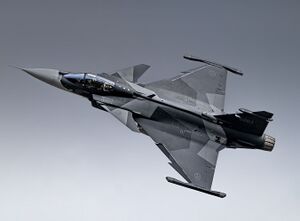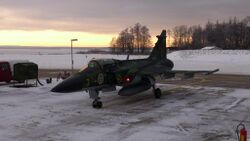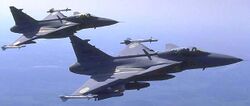JAS-27 Rook
| Aestrup JAS-27 Rook | |
|---|---|

| |
| A Royal Acrean Marine Corps JAS-27E over the Gulf of Åland, 2022 | |
| Role | Multirole fighter |
| National origin | |
| Manufacturer | Aestrup ASA |
| Design group | Aestrup ASA Tionscail Ríoga Aeraspáis |
| First flight | 1 October 1983 |
| Introduction | 14 December 1988 |
| Status | In active service |
| Primary user | |
The Aestrup JAS-27 Rook is a single-engine, 4.5 generation fighter produced by Aestrup Stridsluftraumsystemet AB for the Royal Acrean Marine Corps and Royal Acrean Air Force. A joint development between Aestrup and Tionscail Ríoga Aeraspáis, the Rook was developed throughout the 1980s taking its delta-canard configuration from the earlier JAS-14 Valkyr, as well as the in-development JAS-26 Draken.
The JAS-27 has numerous differences which set it apart from the T-32. When the production Rook debuted in 1988, it was internally and externally different from the Ossorian T-32 which accompanied it. The Rook is slightly larger to accommodate a more powerful engine and increased fuel and payload capacity. It included a different avionics suite, and different onboard systems. The most modern variant is the JAS-27E improved with composite construction, upgraded inter-aircraft networking, and redesigned sensor fusion.
Development
The Flygsystem 90 (FS90) project began in the late 1970s as a joint program between Acrea and Ossoria to develop a new multirole lightweight fighter. Although the Acrean and Ossorian militaries had different intended roles for the fighter, the initial requirements drawn up were close enough to join together on the project. Development was initially conducted off the back of the successful JAS-14 Valkyr which saw service in Acrea and Ruvelka. It's low maintenance requirements, high cost efficiency, and short takeoff and landing characteristics were considered highly desirable, particularly by the RAMC which sought a replacement for the Valkyr for its fixed-wing aircraft corps. These characteristics were to be combined with those of the EF-161 Raven which had entered RAAF service only a few years earlier. The intended result was to be an economical, flexible, highly maneuverable multirole fighter.
Design
The JAS-27 Rook is a single engine multirole tactical fighter. It was designed to be lightweight, highly maneuverable, cost effective, and easy to maintain. Unlike the earlier JAS-16, the Flygsystem 85 was designed to be a multirole fighter from the outset. Although the final product suited Ossorian requirements, it was not considered to be suitable by the RAMC and RAAF. Consequently, the JAS-27 debuted with substantial changes to enhance its air-to-air performance; it was fitted with the then-brand new EJ-900-91 engine providing 87 kN of thrust in mil power and 142 kN in reheat. Additionally, the aircraft's flight control systems were tinkered with, and its avionics revamped. The radar was replaced and an IRST added, with the fire control systems replaced by Acrean systems adapted from the EF-161. This allowed the aircraft to be compatibly with Acrean helmet mounted cueing systems and allow it to take advantage of the high off-boresight capability of Acrean missiles. The airframe was slightly enlarged, a change that would be adopted by the Ossorian Air Force in the design of the T-32E, and the cockpit slightly raised and the forward upper fuselage modified to increase visibility. The gun was replaced by a 27mm revolver cannon.
Moderate improvements were made to the aircraft over its lifespan in service. The Block CI production lot introduced thrust vectoring with the multi-axis MAVS system, which was integrated with a new flight control system. This modification heavily increased the flight performance of the airframe; in addition to providing it with exceptional low-speed authority, it also enhanced energy performance by utilising both the MAVS system and flight control surfaces to maneuver the aircraft with the least amount of drag.
Modern Rooks are made with composites to lower their radar cross section. Radar and sensor systems are largely derived from the EFX fighters, and their sensors and computer systems constitute the most complex and expensive parts of the aircraft's development. The Rook carries an AESA radar, complimented by an IRST equipped with a magnified long-range optical sight to aid in long range identification, an , and a SOL integrated electronic warfare and countermeasure system. SOL contains a SAIRST/DAS consisting of high-resolution infrared sensors directed around the airframe to provide near full spherical coverage. The SAIRST and the aircraft's RWR provide detection of both infrared and radar-guided missile launches, and the SAIRST also directs infrared imaging countermeasure against incoming infrared missiles. The Rook utilises data link to share information gathered through its variety of sensors with both friendly Air Force and Navy aircraft.
Usability and Maintenance
Like the EF-137 it replaced, the JAS-27 was designed around low-cost operation in austere or ersatz conditions with minimal maintenance requirements, which remains one of its key features. This requirement was directly drawn from its development from the EF-137. The Rook is designed with modularity in mind, meaning that every major component is part of a module which can be rapidly and easily replaced, repaired, or swapped in field conditions. All aircraft are fitted with a Health and Usage Monitoring System (HUMS) that monitors the stress and performance of various aircraft systems and components, and provides information to technicians and maintainers to assist in servicing it.
In the field, the Rook is able to operate with a runway space of 600 meters long, and 12 meters wide. This enables it to be used on ersatz runways constructed from highways and major roads, as well as temporary runways and landing strips. The Rook was designed to be serviced by a small team and have a short turnaround time; during combat operations, a Rook can be refueled, re-armed, and undergo basic inspection and servicing within ten to twenty minutes (depending on mission type) by a team of six maintainers and technicians.
Avionics
Cockpit
The Rook uses a full glass cockpit and all-digital flight instruments. The head's up display (HUD) is used as the primary flight instrument, with symbology and information for various flight modes displayed for the pilot. was displayed originally on three large liquid-crystal multi-function Head's Down Displays (HDDs) arranged in the cockpit. This cockpit design was changed slightly for the Rook NG. The three LCD MFD displays were replaced by a single large LCD touchscreen multi-function wide area display with further improved fidelity and resolution, complimented by two additional smaller displays on either side of the cockpit in a similar arrangement to the JA65 Striga. Despite the addition of touchscreen capability, tactile buttons for manipulating the MFDs were retained by demand of pilots. The cockpit displays underwent additional updates in 2015. The Rook NG also implemented a new helmet-mounted display system (HMDS), allowing pilots to display all flight and combat information, usually displayed on the HUD, in their visors. As a result of this, the Rook's traditional HUD frame was replaced with a more discrete, thinner framed display.
Comparison to T-32 Spéirling
Operational History
Zemplen War
Midsummer War
Variants
- JAS-27A: First series aircraft introduced in 1988.
- JAS-27C:
- JAS-27E: The Rook E is a comprehensive modernisation of the aircraft introduced into RAMC service in 2016. AESA radar, new electronic warfare systems, as well as a fully redesigned internal cockpit eliminating old instruments and replacing them fully with high-resolution LCD displays, and using improved sensor and system integration derived from the EF-662 program and EF-165 modernisation program.
Operators
Current Operators
Specifications (JAS-27E)
General Characteristics
- Crew: 1
- Length: 15.5 m
- Wingspan: 8.8 m
- Height: 4.5 m
- Wing Area: 31 m²
- Empty Weight: 7,800 kg (17,200 lbs)
- Max Takeoff Weight: 16,500 kg (37,000 lbs)
- Powerplant: 1x MDA EJ-900-5 afterburning turbofan, 90 kN (20,233 lbf) dry thrust, 145 kN (32,500 lbf) reheat
- Fuel Capacity: 3,500 kg (7,700 lbs) internal
Performance
- Maximum Speed: Mach 2.05 at altitude
- Mach 1.25 at sea level
- Mach 1.2 supercruise at altitude
- Service Ceiling: 58,000 ft


